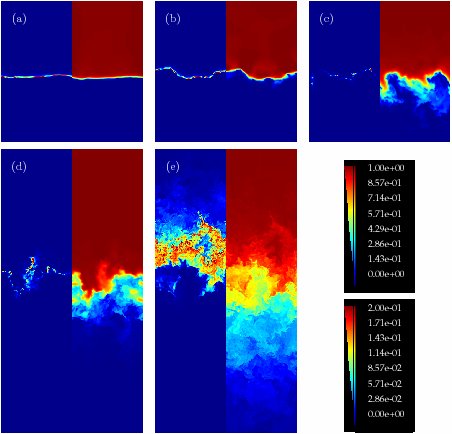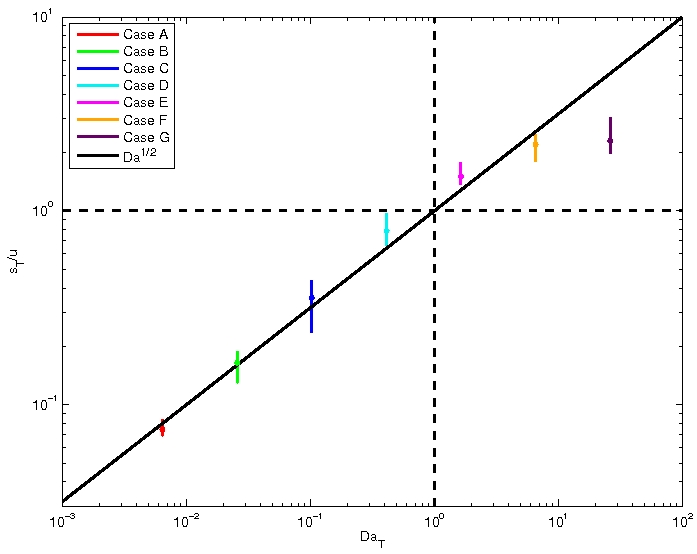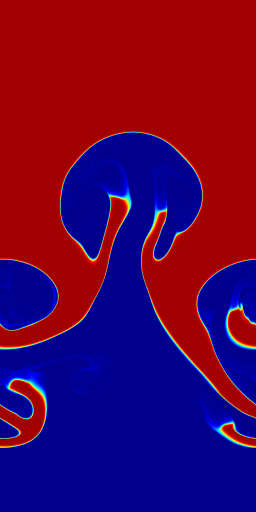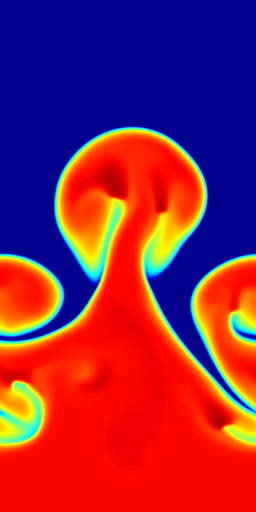
Home |
Research |
Publications |
People |
AMReX |
MODS |
Small-Scale Thermonuclear Flames in Type Ia Supernovae
Currently, the accepted model for Type Ia supernovae is the explosion of a carbon-oxygen white dwarf. Observational evidence is inconsistent with the nuclear burning occurring in a prompt detonation mode. Detailed computations show that a detonation predicts excess amounts of iron and fails to account for significant amounts of intermediate mass elements observed in the spectra of supernovae events. For this reason, it is believed that at least the initial phases are governed by the propagation of constant-pressure deflagrations. However, to obtain the energy generation rate needed to explode the star the deflagration must be dramatically accelerated relative to the laminar flame speed of the burning front.
Our method introduces a low Mach number formulation of nuclear flames that alleviates the acoustic time step constraint. This approach, based on low Mach number asymptotics, uses a projection formulation coupled with higher-order Godunov advective differencing that allows time-steps based on advection speeds rather than acoustic speeds. For problems in combustion, governed by an ideal gas equation of state, the low Mach number approach has seen substantial development and has been successfully applied to simulation of laminar and turbulent flames in two and three dimensions. The methodology presented here generalizes the approach of Day and Bell to the nuclear deflagration regime. In particular, we discuss the extension of the low Mach number methodology to degenerate equations of state typical of stellar environments.
Research Highlights
Turbulence-Flame Interactions in Type Ia Supernovae
|
The complex small-scale dynamics of turbulent thermonuclear flames are essential to understanding Type Ia supernovae (SN Ia) explosions. In this paper we consider a carbon-burning thermonuclear flame at a variety of Karlovitz numbers, spanning a range of burning regimes from the flamelet regime to the distributed burning regime. For moderate Karlovitz numbers, the thermodiffusively stable nature of the flame leads to local extinction and enhancement, which is correlated with local curvature. For the highest Karlovitz number simulated here (Ka=230), a fundamentally different burning behavior is observed. Turbulent mixing dominates thermal diffusion and a distributed flame is observed. The local burning rate is greatly reduced, but is outweighed by the volume of fuel burning, and so the resulting turbulent flame speed is around 5 or 6 times faster than the laminar flame speed. |

|
More information can be found here......
Distributed Flames in Type Ia Supernovae
More information can be found here......
Buoyant Burning Bubbles in Type Ia Supernovae
More information can be found here...
Two-Dimensional Instabilities
More information can be found here......
Publications
 A. J. Aspden, J. B. Bell, S. Dong, and S. E. Woosley,
"Burning Thermals in Type Ia Supernovae",
Astrophysical Journal, 738, 94-107, 2011.
[ApJ]
A. J. Aspden, J. B. Bell, S. Dong, and S. E. Woosley,
"Burning Thermals in Type Ia Supernovae",
Astrophysical Journal, 738, 94-107, 2011.
[ApJ]
 A. J. Aspden, J. B. Bell, and S. E. Woosley,
"Distributed Flames in Type Ia Supernovae", Astrophysical Journal,
710, 1654-1663, February 2010.
[ApJ]
A. J. Aspden, J. B. Bell, and S. E. Woosley,
"Distributed Flames in Type Ia Supernovae", Astrophysical Journal,
710, 1654-1663, February 2010.
[ApJ]
 S. E. Woosley, A. R. Kerstein, V. Sankaran, A. J. Aspden and F. Ropke
"Type Ia Supernovae: Calculations of Turbulent Flames Using the Linear Eddy Model",
Astrophysical Journal, 704, pp.255-273, 2009.
[ApJ]
S. E. Woosley, A. R. Kerstein, V. Sankaran, A. J. Aspden and F. Ropke
"Type Ia Supernovae: Calculations of Turbulent Flames Using the Linear Eddy Model",
Astrophysical Journal, 704, pp.255-273, 2009.
[ApJ]
 S. E. Woosley, D. Kasen, H. Ma, G. Glatzmaier, A. J. Aspden,
J. B. Bell, M. S. Day, A. R. Kerstein, V. Sankaran, F. Ropke,
"Type Ia Supernovae",
Proceedings of Science, 10th Symposium on Nuclei in the
Cosmos, July 27 - August 1 2008, Mackinac Island, Michigan, USA.
[pdf]
S. E. Woosley, D. Kasen, H. Ma, G. Glatzmaier, A. J. Aspden,
J. B. Bell, M. S. Day, A. R. Kerstein, V. Sankaran, F. Ropke,
"Type Ia Supernovae",
Proceedings of Science, 10th Symposium on Nuclei in the
Cosmos, July 27 - August 1 2008, Mackinac Island, Michigan, USA.
[pdf]
 S. E. Woosley, A. J. Aspden, J. B. Bell, A. R. Kerstein, V. Sankaran,
"Numerical simulation of low Mach number reacting flows",
SciDAC 2008, J. of Physics: Conference Series,
Seattle, Washington, July 2008.
[pdf]
S. E. Woosley, A. J. Aspden, J. B. Bell, A. R. Kerstein, V. Sankaran,
"Numerical simulation of low Mach number reacting flows",
SciDAC 2008, J. of Physics: Conference Series,
Seattle, Washington, July 2008.
[pdf]
 A. J. Aspden, J. B. Bell, M. S. Day, S. E. Woosley, M. Zingale,
"Turbulence-Flame Interactions in Type Ia Supernovae",
Astrophysical Journal, 689,
pp.1173-1185, December 20, 2008.
[ApJ]
A. J. Aspden, J. B. Bell, M. S. Day, S. E. Woosley, M. Zingale,
"Turbulence-Flame Interactions in Type Ia Supernovae",
Astrophysical Journal, 689,
pp.1173-1185, December 20, 2008.
[ApJ]
 J. Bell, A. J. Aspden, M. Day, M. Lijewski,
"Numerical simulation of low Mach number reacting flows",
SciDAC 2007, J. of Physics: Conference Series,
Boston, Massachusetts, July 2007. LBNL Report No. LBNL-63088.
J. Bell, A. J. Aspden, M. Day, M. Lijewski,
"Numerical simulation of low Mach number reacting flows",
SciDAC 2007, J. of Physics: Conference Series,
Boston, Massachusetts, July 2007. LBNL Report No. LBNL-63088.



